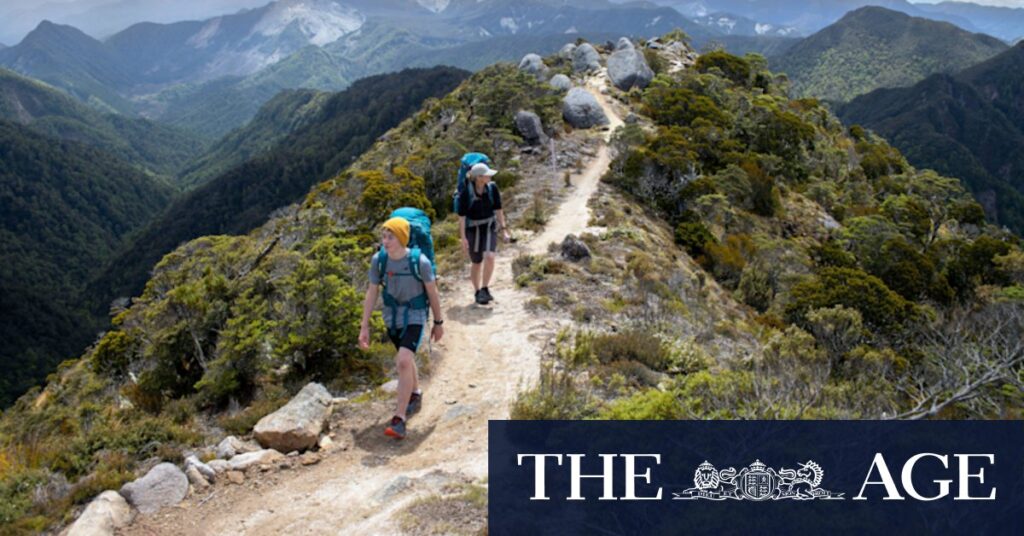
I refuse to look up. If I look up, I know what I’ll see: another set of steps that require me to lift not only my feet but also the 12 kilograms of food, water, spare clothes, and equipment I’m carrying on my back. My “one step at a time” mantra is now my curse. My glutes are screaming; I’ve run out of swear words. But still … these trees, dripping with webs of emerald moss, the playful, chatty robins and cheeky, food-stealing wekas, that breath-halting view as we exit thick canopy to stunning vistas of distant islands. I wouldn’t want to be anywhere else.
We’re on day one of the Hump Ridge Track, New Zealand’s latest Great Walk. The looped, three-day, 62-kilometre track in the South Island’s Fiordland National Park is about two-and-a-half hours south-west of Queenstown and 30 minutes from the small town of Tuatapere (the self-declared sausage capital of New Zealand). While Hump Ridge officially became a trail in 2001, it was designated a Great Walk last October, joining 10 others around the country.
The Journey Begins
My trekking partner and I are also in New Zealand to walk the 85-kilometre Old Ghost Road in the South Island’s Kahurangi National Park. But first, we need to conquer this elevation: the much-anticipated, 1000-plus-metre-high “hump” that is the main topic of conversation among our fellow hikers.
Even though the climb is leaving us breathless, so too is the scenery. We’ve tramped through a coastal forest, wandered along a desolate beach dotted with perfect conch shells, and wobbled across long swing bridges, high above stony creeks. The canopy becomes less dense as we scale the 3600 steps that were cut into the mountain by local volunteers, and when we reach our rest stop, Stag Point, for a few brief minutes, we see the Southern Ocean and all the way to Stewart Island before the clouds close in. We strap on our backpacks again as the wind picks up and pushes us towards the final stretch of looping boardwalk, framed by alpine plants, and on to the first of our walk’s two huts.
Hut Life and Community
The huts – Okaka and Port Craig – are staffed by knowledgeable Department of Conservation wardens who help out with inquiries, advise on the weather and terrain, and make huge vats of creamy porridge in the morning. There are flush toilets (not always a given on the Great Walks) as well as a kitchen with gas stoves and basic utensils. If you want, you can pay $NZ20 ($19) for a token-operated, three-minute hot shower. And of course, we do. The huts also sell basic foods, but we carry our own and keep it as light as possible: hello three days of dried noodles and dehydrated vegies in miso soup.
The Percy Burn is the longest wooden viaduct in the southern hemisphere.
The lack of any mobile reception makes the huts truly communal. We chat with people from all over the world, including a recently married American couple who thought a New Zealand Great Walk was the perfect destination for a honeymoon. “Today’s climb wasn’t as hard as I thought,” the young bride says while the rest of us wait for her to tell us she’s joking. She doesn’t.
Challenges and Triumphs
Knowing the toughest part of the walk is over, the atmosphere is light, but day two towards Port Craig brings different challenges: it’s largely downhill, with more than 3000 steps interrupted by short, hand-made boardwalks that help us avoid the mud while also protecting the landscape’s fragile alpine plants. We stop for a break at Luncheon Rock, a slab of granite jutting out from the ridge. From here, our guidebook states, the views are incredible – and I’m sure they are, behind the insistent cloud cover.
As we continue, the track’s history unfolds. Originally constructed to support the local logging industry, the Hump Ridge Track has been transformed into a conservation success story. The local community’s efforts to preserve the area’s natural beauty are evident in every step we take.
Looking Forward
As New Zealand’s latest addition to its prestigious list of Great Walks, Hump Ridge Track is set to attract more visitors eager to experience its unique blend of natural beauty and challenging terrain. The designation as a Great Walk not only highlights the track’s significance but also ensures continued investment in its maintenance and preservation.
For those considering the trek, preparation is key. The track’s varying landscapes and weather conditions demand respect and readiness. Yet, for all its challenges, the Hump Ridge Track offers an unparalleled opportunity to connect with nature and fellow adventurers in one of the world’s most breathtaking settings.
As we conclude our journey, the memories of emerald moss, sweeping ocean views, and shared stories with strangers will linger long after the final step is taken. The Hump Ridge Track is more than just a walk; it’s an experience that captures the essence of New Zealand’s wild heart.





